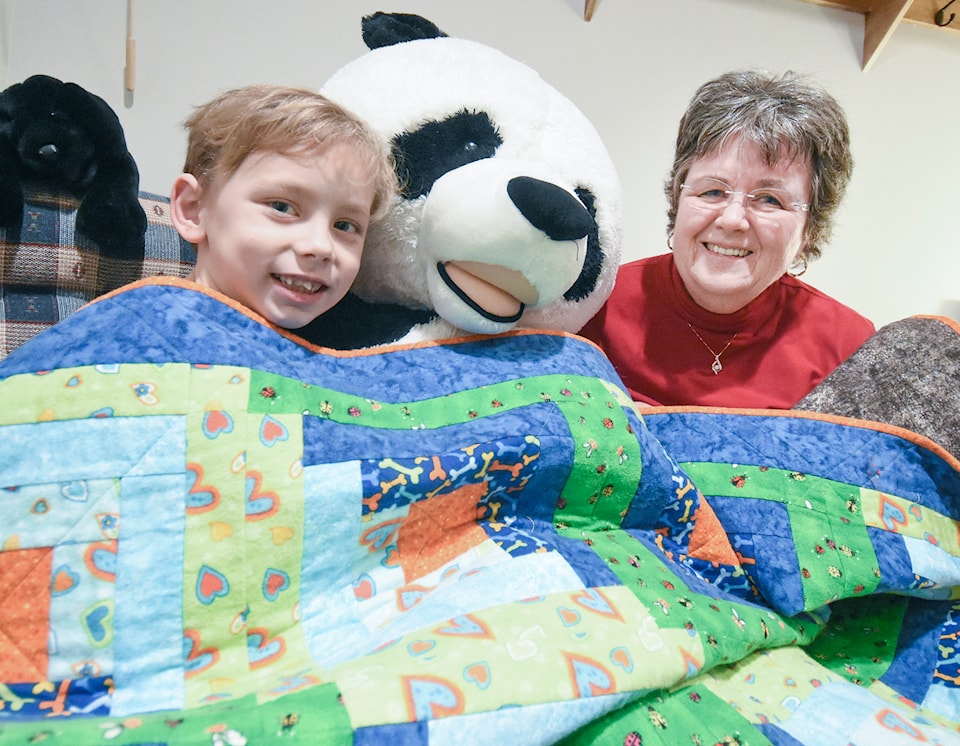Marianne Schneider and Veronika Schrank are a generation apart, but sadly their lives are similar in many respects.
Both women lost their husbands at an early age, leaving each of them with the challenge of trying to help four young children understand and cope with something they could never have imagined.
It was 34 years ago Schneider’s husband Peter died of cancer and just five years ago Schrank experienced a similar loss.
The women’s paths crossed recently at the Penticton and District Hospice Society’s children’s bereavement support program.
Out of her appreciation of what the program provides for children who have lost a family member, something she didn’t have in 1983 when her husband died, Schneider decided to make a quilt for the children in the program to sit on.
Coincidently, some of those youngsters who now get to enjoy the soft, fluffy blanket during their time at the centre includes Schrank’s seven-year-old son Alex and two of her three daughters.
She too had nowhere to turn for help until the program at first.
Read more: Grief resource for South Okanagan children
Schneider recalled why she decided to make the quilt.
“Susan (children’s grief counsellor Susan Kast) was using a table cloth on the floor for the kids to sit on and I thought hey, you don’t need to do that. So I knitted the quilt and gave it to her,” said Schneider with a laugh. “Really, this program Susan has is so important. Kids need to talk to somebody, maybe somebody a little distant from it.”
At the time their father died her children were aged two, five, nine and 11.
“I was grieving so badly at that time and you don’t see a lot of stuff with the kids at that stage,” she recalled.”I tried to carry on the way it was before and I told them daddy’s gone to heaven. What else could I say, they understood that. It wasn’t any more complicated than that.
“The kids still have difficulties with it today, you see it come out when they sit down and have a few beers together and the tears flow.”
For Schrank, having the help from Kast and the children’s bereavement program has meant more to the family than she can put into words.
“Everybody deals with grief on their own level and on their own time and sometimes I think society forgets that our children are children. They don’t just get over it, that’s why this is so important,” said Schrank. “My son was little when his dad passed away but now that he’s growing up he’s grieving in different and more ways. This way my kids get to see they’re not alone.”
The children’s bereavement program, believed to be the only one of its kind in the South Okanagan has been provided by the hospice society since 2013.
The free service, offered without referral, is done on a one-on-basis and as well there are two monthly group sessions. The society, which also operates Moog &Friends Hospice House, is funded by donation.
“Just for these kids to meet other kids who really do understand is very important,” said Kast. “These children really do feel different and they often feel like other people just don’t understand. You can see in the group that connection that forms between them sometime they get together and just talk about stuff just like regular kids.”
She often hears from parents they notice their children seem to have less anger, tension and frustration and are better able to express themselves and talk about their feelings. “And when I talk to parents and hear the kids are looking forward to coming back, that tells me me this is really meeting a need,” said Kast.
She added the quilt has also had an impact on the children.
“It’s symbolic but it’s also tangible because it shows the kids there are people out there who really care about them,” said Kast. “Someone who cares enough about them to spend hundreds of hours working on this for them.
“It speaks to the fact Marianne understands and appreciates the impact of this support service, something that wasn’t there for her.”
According to Schneider the quilt design is a traditional one and fitting for it’s use in the program: “The pattern is a log cabin and the centre is orangey-red to represent the hearth in the middle of the family, the place where everyone gathers.”
